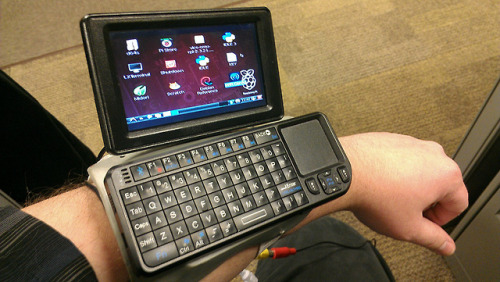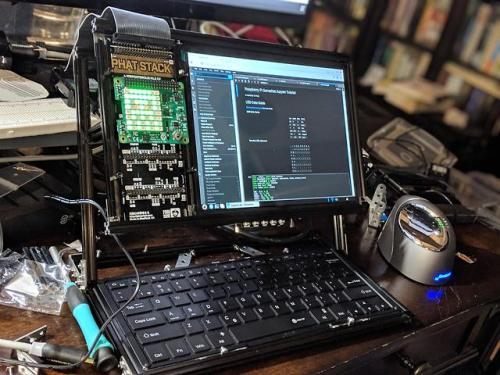Finished One Of My Altoids-friendly Arduino Menta’s From Adafruit


Finished one of my Altoids-friendly Arduino Menta’s from Adafruit
More Posts from Forward-lang-blog and Others

Wearable Raspberry Pi by Jason Benson on flickr, who is clearly living in 3018
MIT’s Slick New UI Lets Your Phone and Desktop Screens Behave as One
By Liz Stinson at Wired. You can read the full article here.
For all the ways the influx of new devices has streamlined our harried lives, it’s produced a parallel problem: the fracturing of our digital ones. What happens on your phone or tablet or computer are siloed experiences that rarely overlap in any meaningful or helpful way. But just think, what if your devices could interact with each other so seamlessly that one screen essentially becomes the other?
This scenario is inching closer to reality with THAW, the newest project out of MIT’s Media Lab. THAW is a program that allows your smartphone and desktop computer to interact with each other so fluidly it’s as though they share the same silicon brain. In the video you watch as files are dragged from a desktop computer and dumped onto an iPhone. In another scene you see a Mario-like video game being played on the desktop only to transfer to the iPhone without skipping a beat. It’s totally trippy, and a little bit surprising. Which is weird because interaction like this is about as intuitive as it comes.
This is really, really cool. If you don’t read the short article, at least check out the video.
The best pull request (PR) in 2017???

A controllable prosthetic hand using electromyography to detect the gestures and muscle activities. The project is aimed to be affordable, upgradable, repairable, and flexible. To make it affordable, it consists of 3D printed parts for structure and only common electronic parts are being used. The hand is controlled through EMG signals read by muscle activities on upper forearm. These EMG signals are then transmitted via Bluetooth to Raspberry Pi. The Raspberry Pi then processes these signals and move servo motors accordingly. The project is still in early state with many areas could be improved.
courtesy: Kenneth V.









At the lab this week I made some printed circuit boards with my new collaborator Jonathan Bobrow. I also learned to solder some super small components to a board.

Adafruit / Beagle Bone Black / Proto Plate / 2013

This guys raspberry pi laptop is goals via Cyberpunk
Never interrupt a programmer
I don't think other coworkers understand how complicated and stressful it is to explain what's going on in your head when you don't even understand specific problems when coding. Hence, I don't want anyone to disrupt me. Same thought in comic format:

Do you agree? Let me know in the comments below.
Credit
Summary:
online trainings on how to use NASA Earth science data, regarding:
air quality,
climate,
disaster,
health,
land,
water resources and
wildfire management.
Everyone (Even You!) Can Use Satellite Data
At NASA we’re pretty great at putting satellites and science instruments into orbit around Earth. But it turns out we’re also pretty great at showing people how to get and use all that data.
One of the top ways you can learn how to use NASA data is our ARSET program. ARSET is our Applied Remote Sensing Training program and it helps people build skills that integrate all these Earth science data into their decision making.

ARSET will train you on how to use data from a variety of Earth-observing satellites and instruments aboard the International Space Station.
Once you take a training, you’ll be in GREAT company because thousands of people have taken an ARSET training.

We hold in person and online trainings to people around the world, showing them how to use NASA Earth science data. Trainings are offered in air quality, climate, disaster, health, land, water resources and wildfire management.
For example, if you’re trying to track how much fresh drinking water there is in your watershed, you can take an ARSET training and learn how to find satellite data on how much precipitation has fallen over a certain time period or even things like the ‘moistness’ of soil and the quality of the water.

Best yet, all NASA Earth observing data is open and freely available to the whole world! That’s likely one of the reasons we’ve had participants from 172 of the approximately 190 countries on Earth.

Since its beginning 10 years ago, ARSET has trained more than 30 thousand people all over the world. They’ve also worked with people from more than 7,500 different organizations and that includes government agencies, non-profit groups, advocacy organizations, private industry.
And even though 2019 is ARSET’s 10th birthday – we’ve only just begun. Every year about 60% of the organizations and agencies we train are new to the program. We’re training just about anyone who is anyone doing Earth science on Earth!
Join us, learn more about how we train people to use Earth observing data here, and heck, you can even take a training yourself: https://arset.gsfc.nasa.gov/.
Make sure to follow us on Tumblr for your regular dose of space: http://nasa.tumblr.com
-
 forward-lang-blog reblogged this · 3 years ago
forward-lang-blog reblogged this · 3 years ago -
 forward-lang-blog liked this · 3 years ago
forward-lang-blog liked this · 3 years ago -
 granthackney liked this · 4 years ago
granthackney liked this · 4 years ago -
 amellestate liked this · 4 years ago
amellestate liked this · 4 years ago -
 mag99 reblogged this · 4 years ago
mag99 reblogged this · 4 years ago -
 tinanewtonart reblogged this · 6 years ago
tinanewtonart reblogged this · 6 years ago -
 tinanewtonart reblogged this · 6 years ago
tinanewtonart reblogged this · 6 years ago -
 tinanewtonart liked this · 6 years ago
tinanewtonart liked this · 6 years ago -
 pakolabs liked this · 6 years ago
pakolabs liked this · 6 years ago -
 coffee-and-lucas liked this · 6 years ago
coffee-and-lucas liked this · 6 years ago -
 mochimiche liked this · 6 years ago
mochimiche liked this · 6 years ago -
 hanaakoganei reblogged this · 6 years ago
hanaakoganei reblogged this · 6 years ago -
 altoids-dealer-blog liked this · 7 years ago
altoids-dealer-blog liked this · 7 years ago -
 lordneverkingofhalloween-blog liked this · 7 years ago
lordneverkingofhalloween-blog liked this · 7 years ago -
 binaryshift liked this · 7 years ago
binaryshift liked this · 7 years ago -
 genderweb reblogged this · 7 years ago
genderweb reblogged this · 7 years ago -
 genderweb liked this · 7 years ago
genderweb liked this · 7 years ago -
 eynrbrzm liked this · 7 years ago
eynrbrzm liked this · 7 years ago -
 kobold-space-program reblogged this · 7 years ago
kobold-space-program reblogged this · 7 years ago -
 zachmcnarp liked this · 7 years ago
zachmcnarp liked this · 7 years ago -
 azurewingssapphireeyes liked this · 7 years ago
azurewingssapphireeyes liked this · 7 years ago -
 coldandalone liked this · 7 years ago
coldandalone liked this · 7 years ago -
 madladthemage liked this · 7 years ago
madladthemage liked this · 7 years ago -
 jorgebandera liked this · 7 years ago
jorgebandera liked this · 7 years ago -
 asfcruppy reblogged this · 7 years ago
asfcruppy reblogged this · 7 years ago -
 superradlover liked this · 7 years ago
superradlover liked this · 7 years ago -
 its-all-bad liked this · 7 years ago
its-all-bad liked this · 7 years ago -
 bisichis liked this · 7 years ago
bisichis liked this · 7 years ago -
 kimbles10 liked this · 7 years ago
kimbles10 liked this · 7 years ago -
 every-lesbian liked this · 8 years ago
every-lesbian liked this · 8 years ago -
 ovacionado liked this · 8 years ago
ovacionado liked this · 8 years ago -
 soy-ang liked this · 8 years ago
soy-ang liked this · 8 years ago -
 felic23203-blog liked this · 8 years ago
felic23203-blog liked this · 8 years ago -
 dr-fingerguns reblogged this · 8 years ago
dr-fingerguns reblogged this · 8 years ago -
 chefrozzi-blog liked this · 8 years ago
chefrozzi-blog liked this · 8 years ago

28 posts